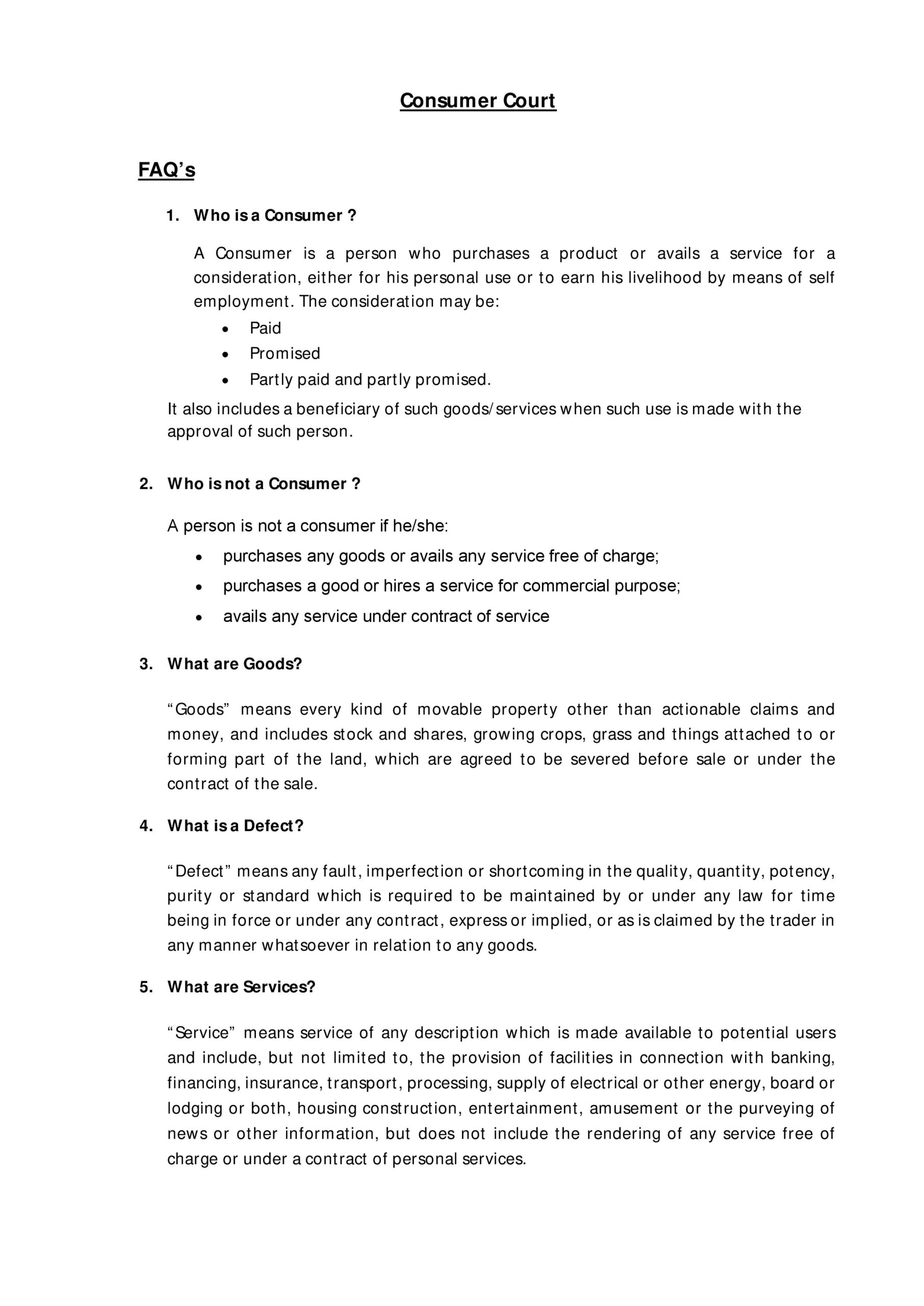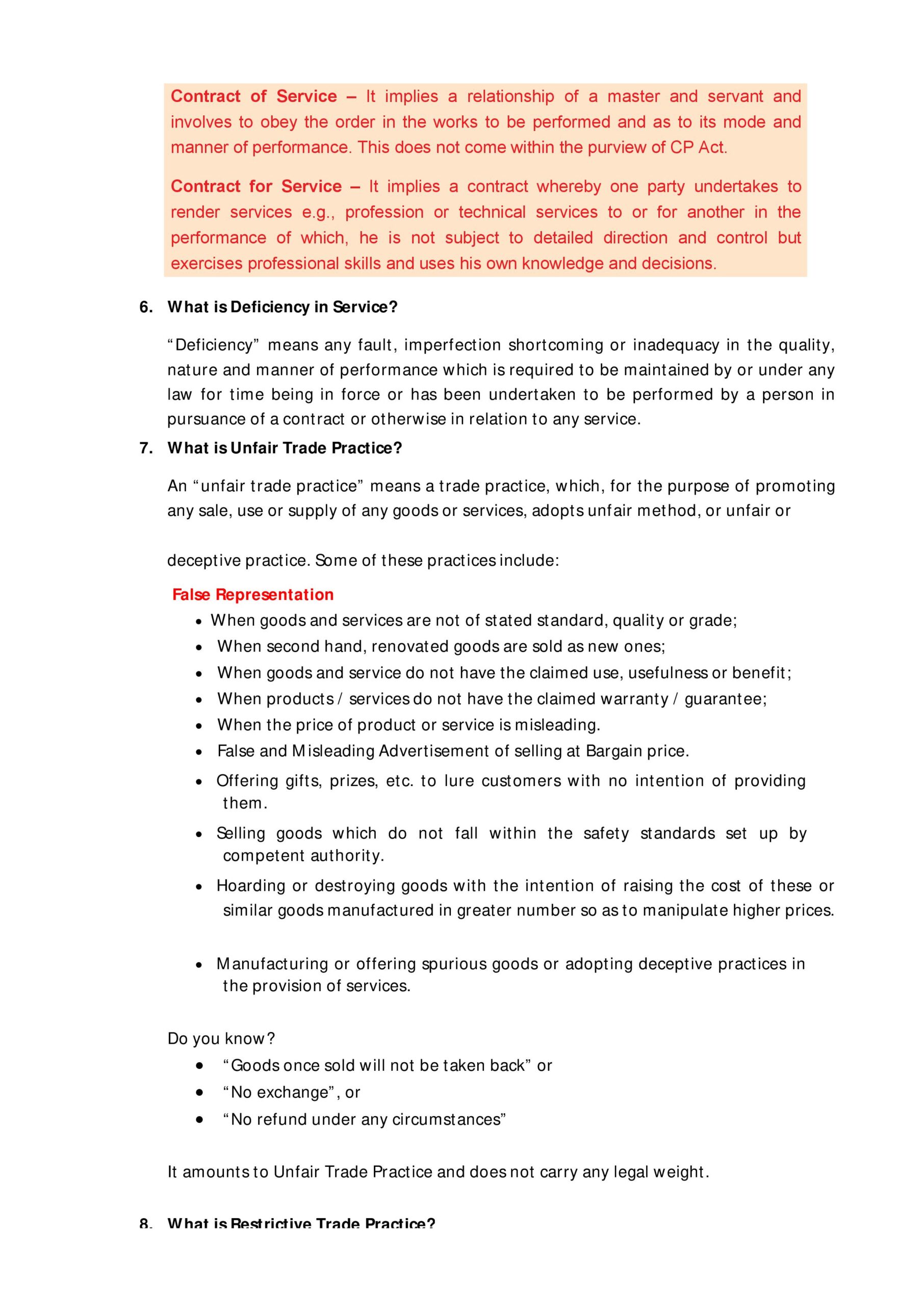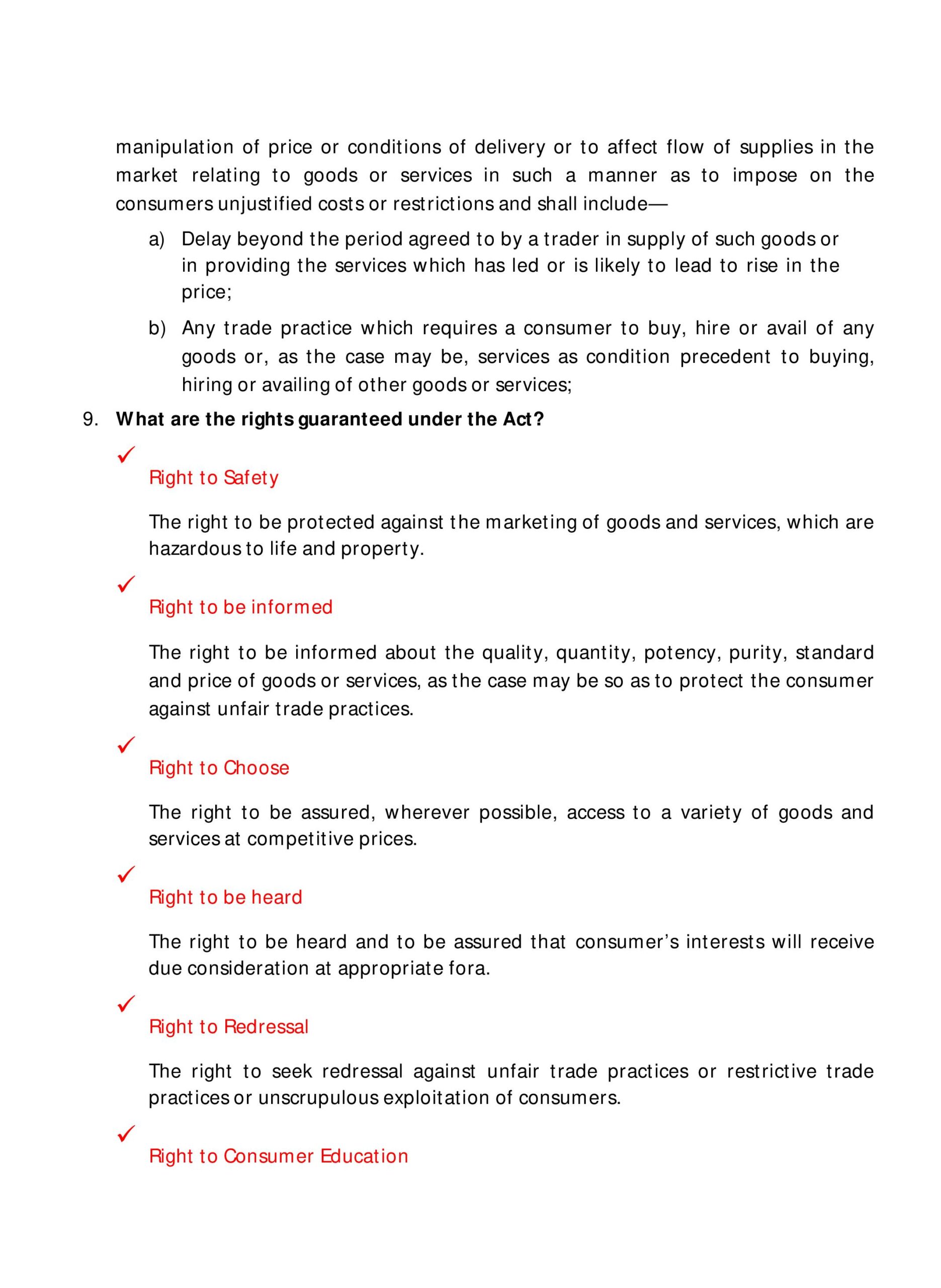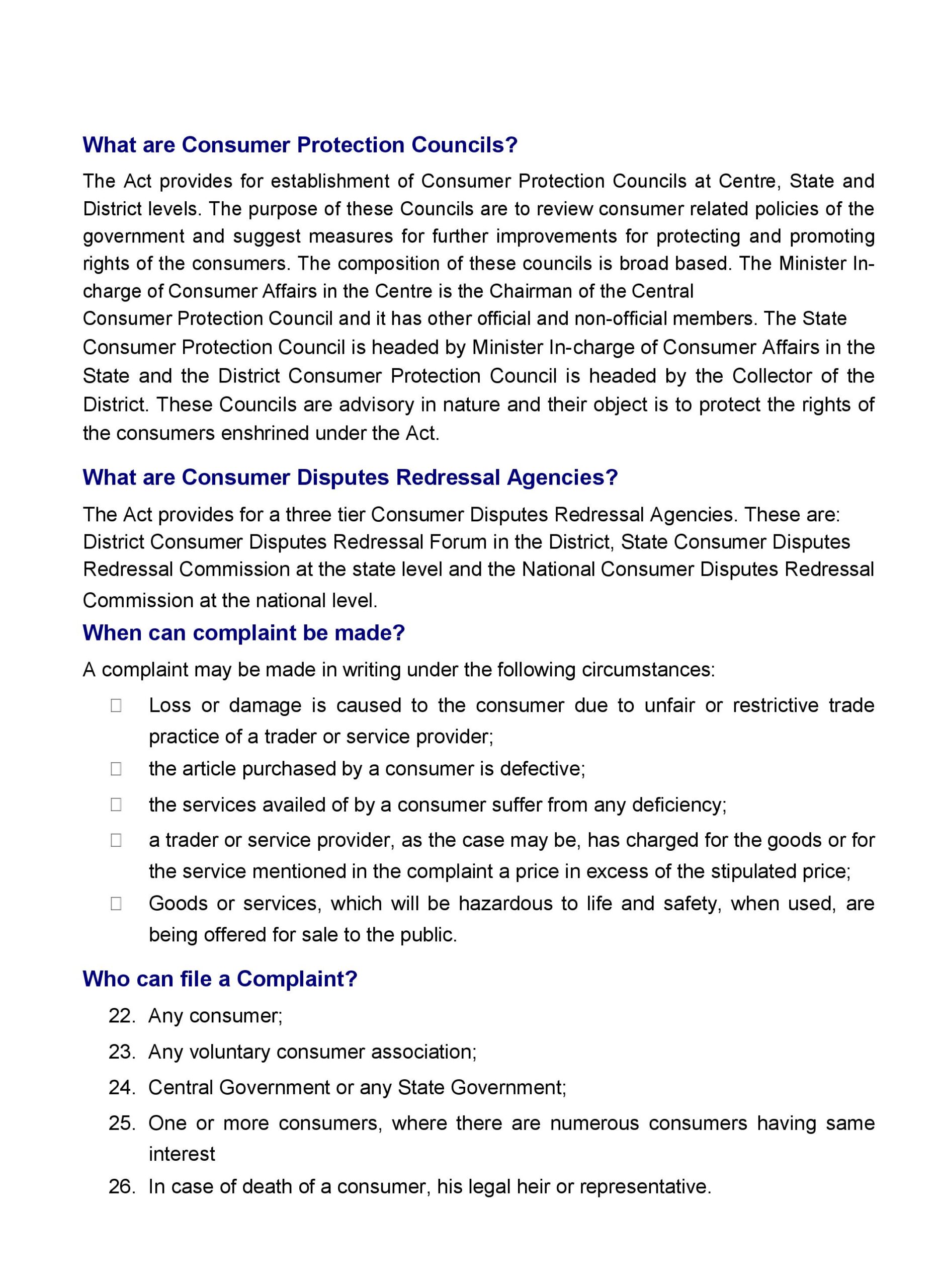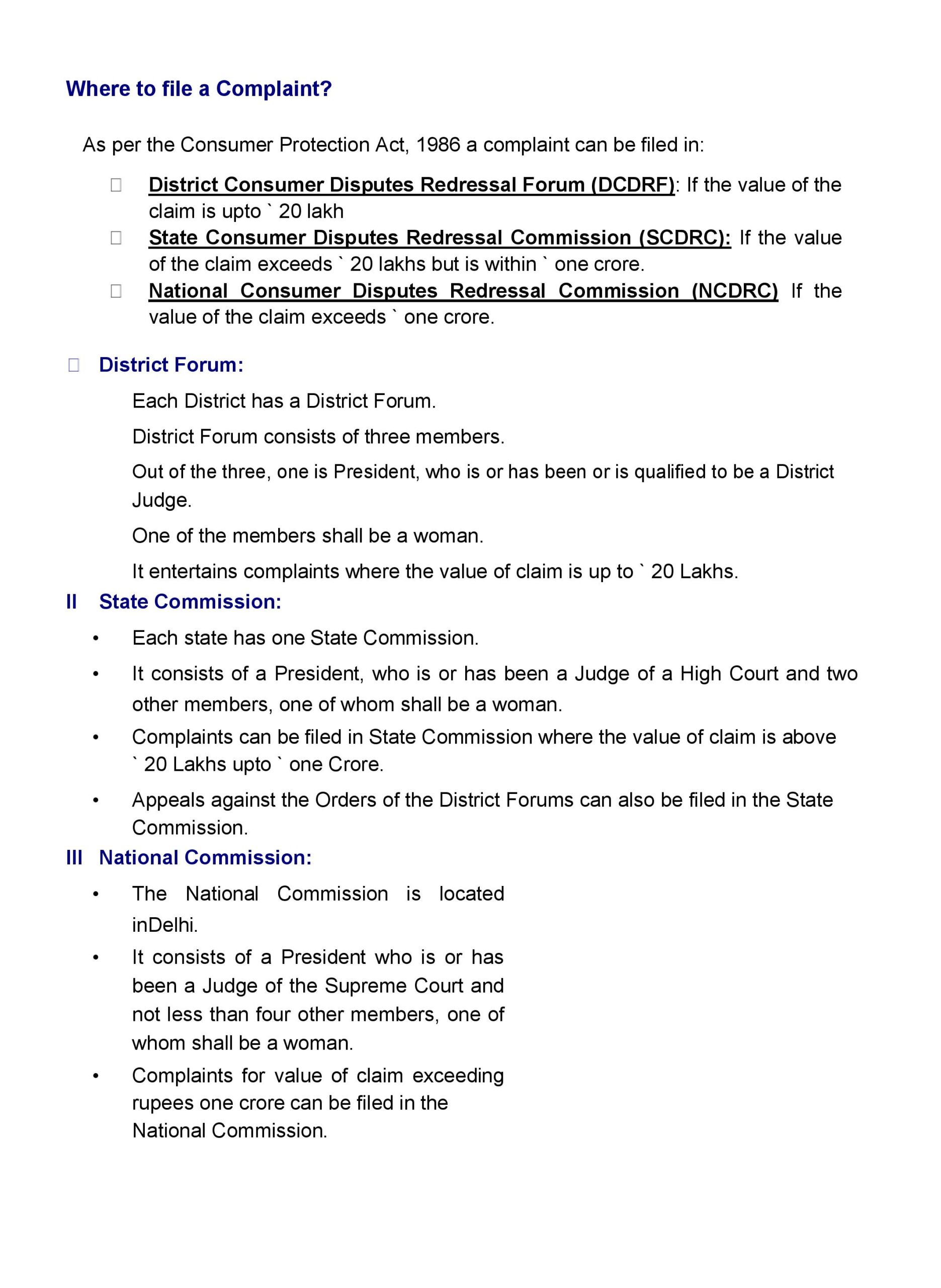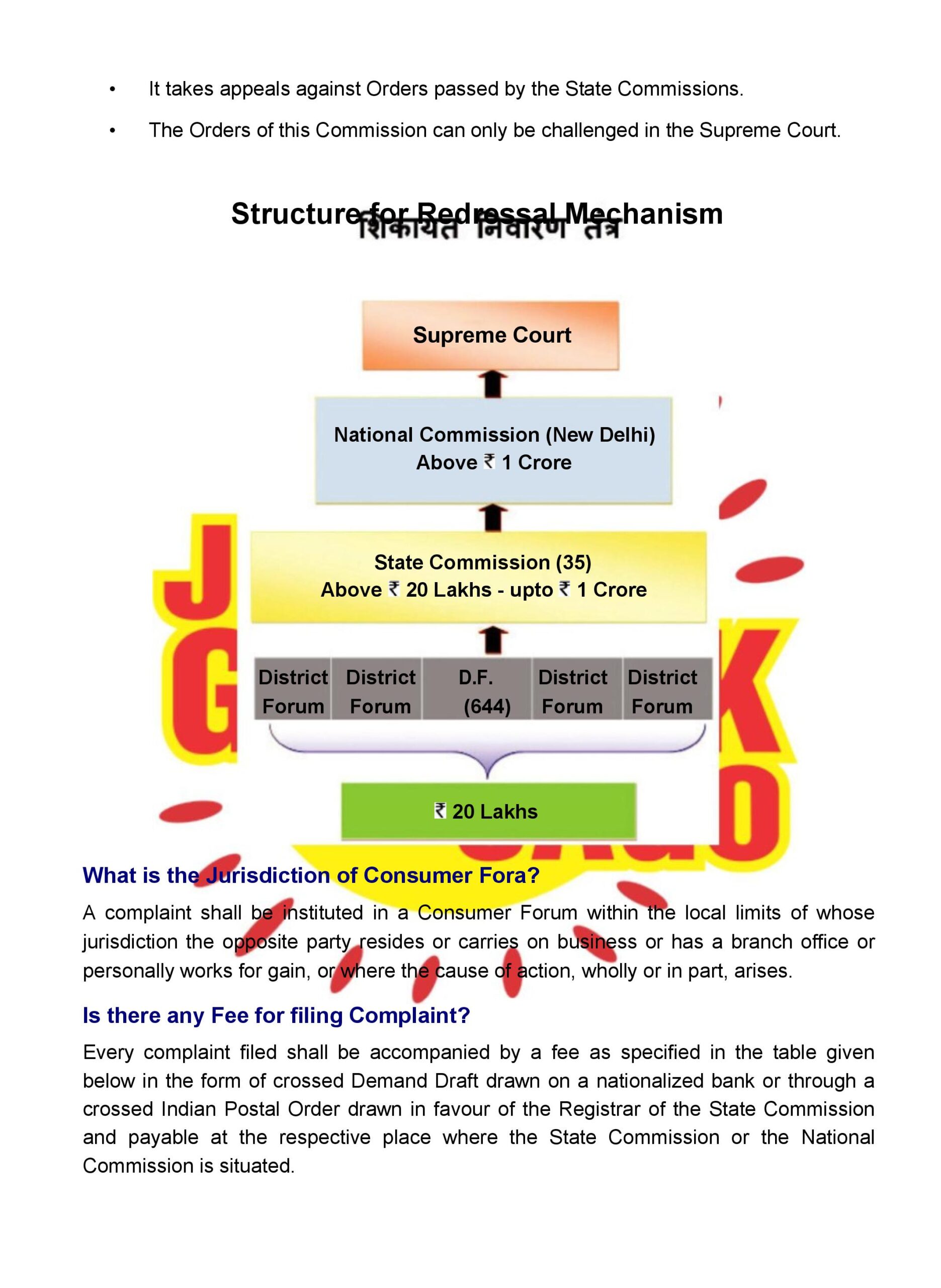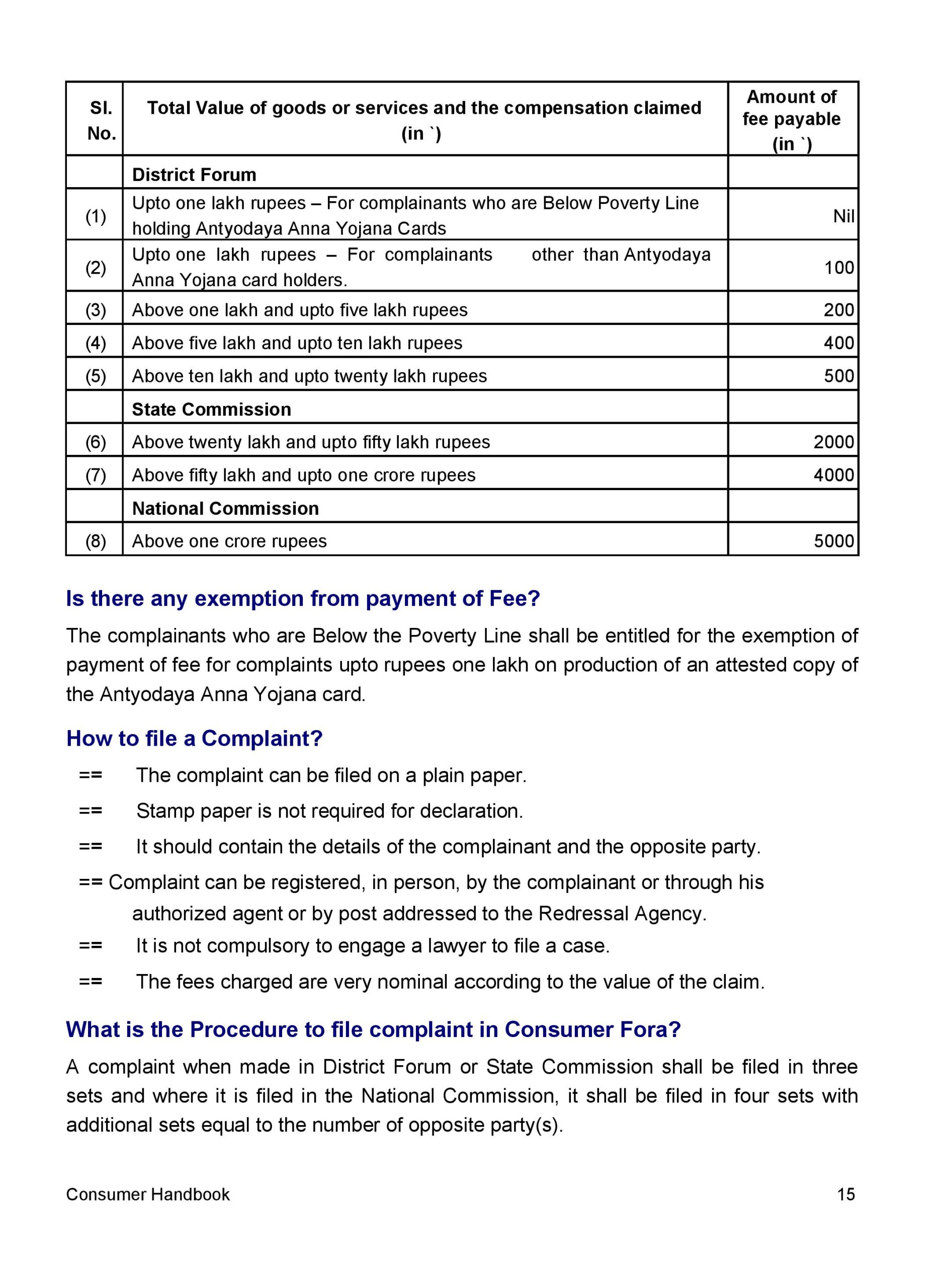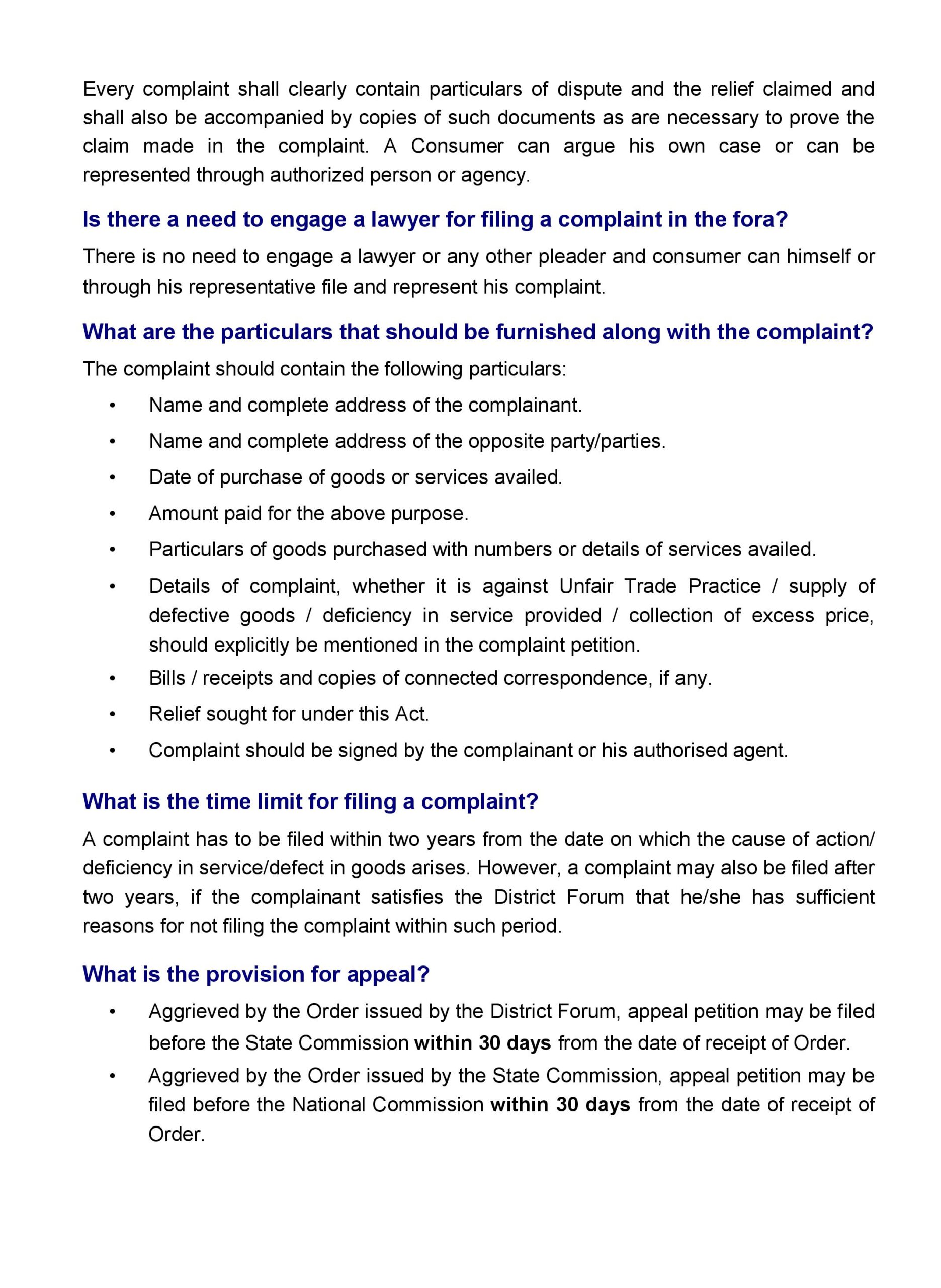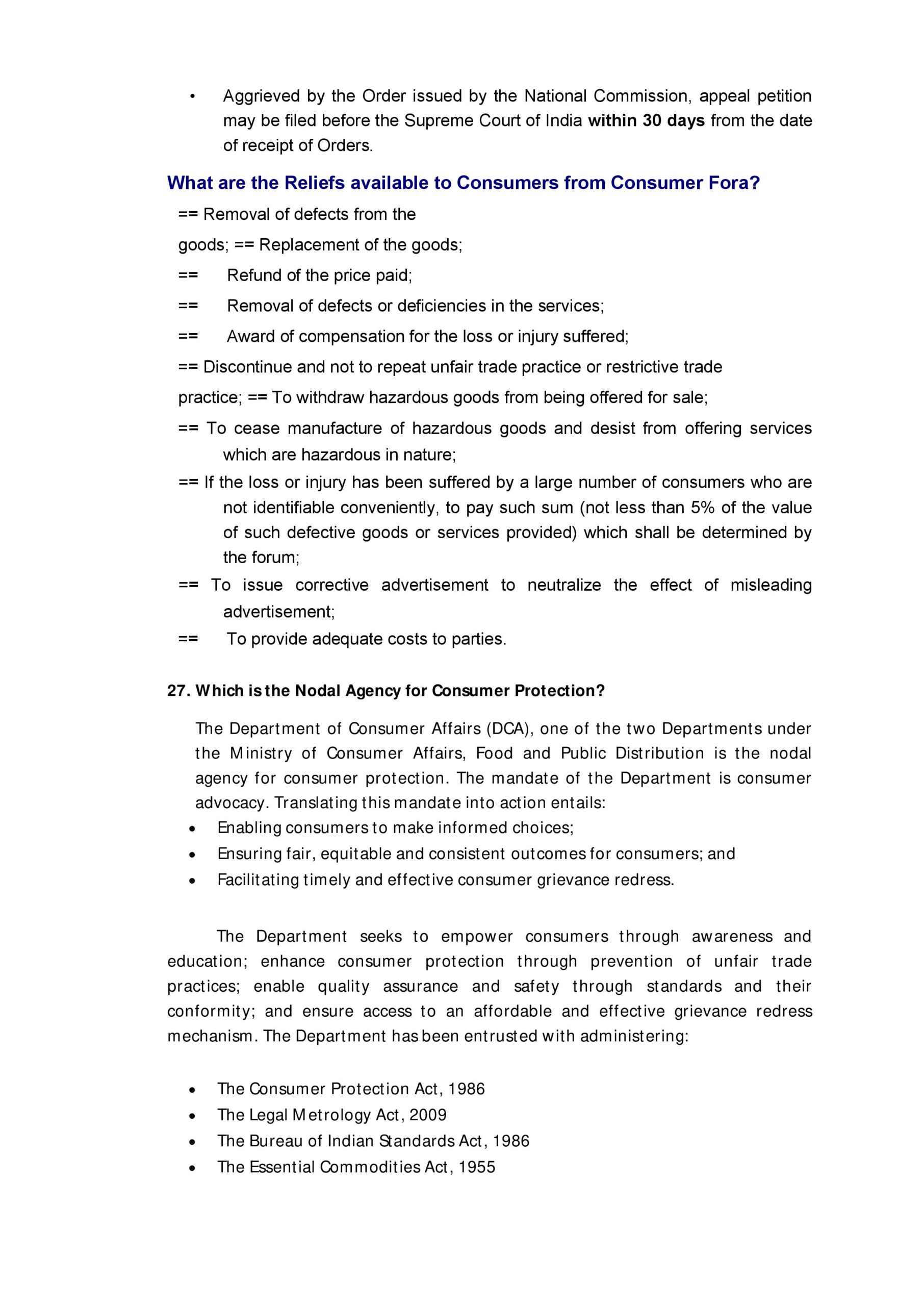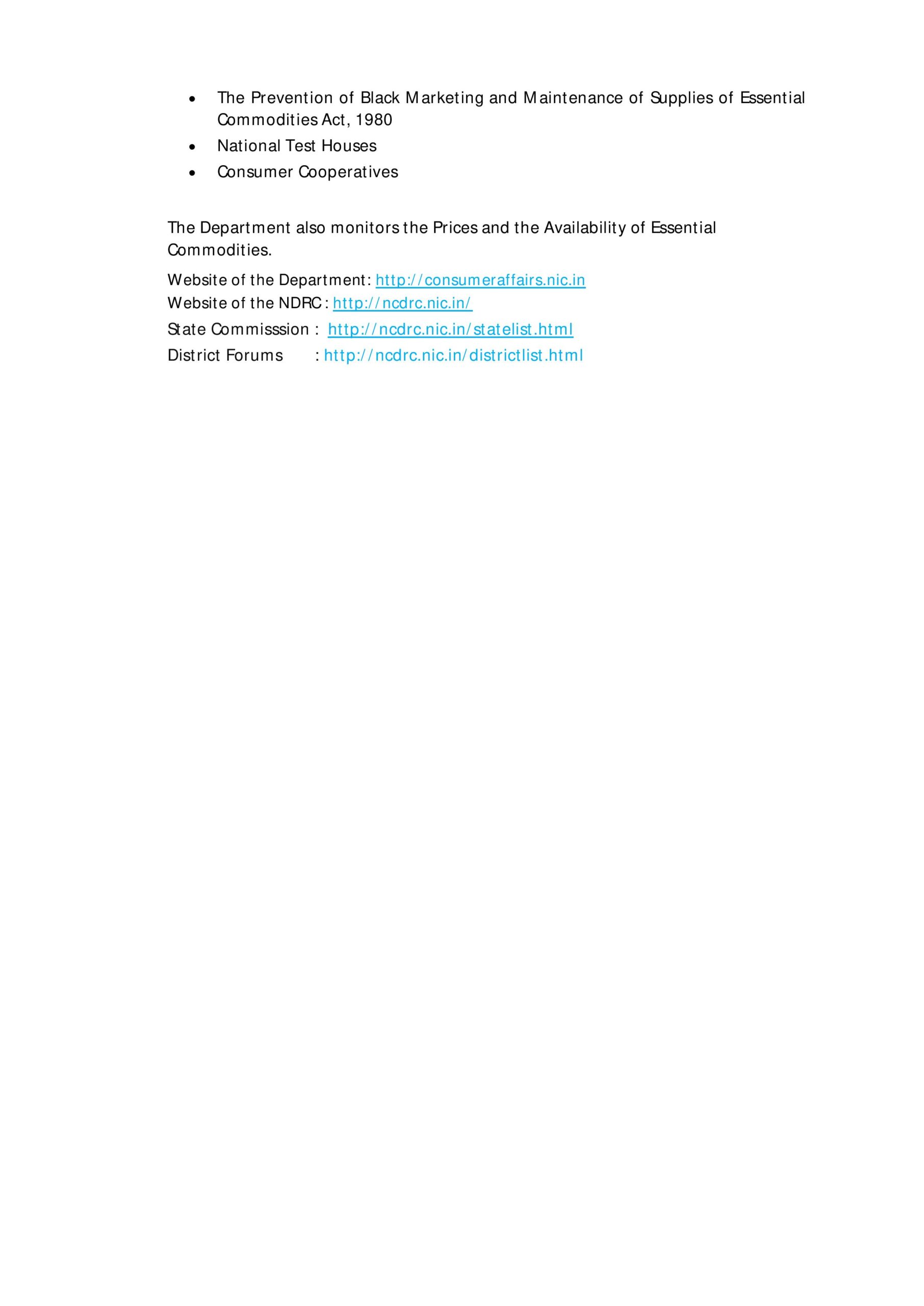Consumer Related Questions and Answers
Question 1. Give any one example of consumer’s ‘right to choose.’
Answer: If you want to buy a toothpaste but the seller says that you can buy a toothpaste only when you buy a tooth brush along with it.
Question 2. If you want to extract information about the functions of any government department, which right would you exercise?
Answer: To extract information about the functions of any government department we would exercise the right to information.
Question 3. Give an example of violation of consumer’s right to choose.
Answer: If you want to buy a toothpaste but the seller says that you can buy a toothpaste only when you buy a tooth brush along with it.
Question 4. How is the maximum retail price printed on packets beneficial for you?
Answer: MRP on a packet is not the final price of the product. We can bargain on it.
Question 5. Give an example of a catchy advertisement to attract consumers.
Answer: A catchy advertisement to attract consumers – “Buy one, Get one”.
Question 6. In what condition is the ‘Right to Seek Redressal’ exercised? Give an example.
Answer: The ‘Right to Seek Redressal’ can be exercised if we are cheated in the market place then as a consumer, we have the right to get compensation depending on the degree of damage.
Question 7. Mention the main legal measure taken by the Indian government in favour of consumers in 1986.
Answer: The main legal measure taken by the Indian government in favour of consumers in 1986 was the enactment of the Consumer Protection Act.
Question 8. How is the Right to Information useful to consumers?
Answer: The Right to Information is useful to consumers as by using it we can get the information about the functioning of the government department.
Question 9. Which logo is used to assure consumers about the quality of jewellery?
Answer: Hallmark logo is used to assure consumers about the quality of jewellery.
Question 10. Suppose you have to buy a packed bottle of drinking water in your journey. Which logo would you like to see to be sure about its quality?
Answer: To be sure about the quality of a packed bottle of drinking water the logo of Agmark should be seen.
Question 11. If any damage is done to a consumer by a trader, under which consumer right one can move to consumer court to get compensation.
Answer: Right to Seek Redressal should be used in case of any damage is done to a consumer by a trader.
Question 12. If you are not interested to buy a brush with tooth paste but shopkeeper denied to sell tooth paste only, which consumer right is being violated by the seller?
Answer: In this case the consumer’s right to choose is violated.
Question 13. Which logo would you like to see on an electric heater to be sure of its quality?
Answer: To be sure about the quality of an electric heater we should see the logo of ISI on it.
Question 14. Which logo would you like to see on gold jewellery to be sure of its quality?
Answer: The logo of Hallmark should be seen on the gold jewellery for its assured quality.
Question 15. Which logo would you like to see for purchasing electrical goods?
Answer: ISI logo should be checked on the purchase of the electrical items for its quality assurance.
Question 16. On which day is ‘National Consumer’s Day’ celebrating every year in India?
Answer: On 24th December, ‘National Consumer’s Day’ celebrated every year in India.
Question 17. Suppose your parents want to purchase gold jewellery along with you, then which logo will you look for on the jewellery?
Answer: In case of gold jewellery, we should see the logo of Hallmark.
Question 18. Why was Consumer Protection Act enacted by the Indian parliament?
Answer: The consumers were cheated in the market place. There was no rule against the exploitation done to the consumers. So Consumer Protection Act was enacted to protect the consumers from such exploitation in the market place.
Question 19. Which logo would you like to see while purchasing a tin of edible oil?
Answer: I would like to see the logo of Agmark while purchasing a tin of edible oil.
Question 20. Name the quasi-judicial machinery, which is set up at the highest level for redressal of consumer disputes.
Answer: National consumer court is the quasi-judicial machinery, which is set up at the highest level for redressal of consumer disputes.
Question 21. When do we celebrate National Consumer’s Day?
Answer: On 24th December, we celebrate National Consumer’s Day in India.
Question 22. How can consumer awareness be spread among consumers to avoid exploitation in the market place? Explain any three ways.
Answer: The three ways through which consumer awareness can be spread among consumers to avoid exploitation in the market place are:
- Advertisement on television channels.
- Through posters and hoardings.
- By making the consumers a well-informed consumer.
Question 23. Analyse any three reasons for the beginning of the consumer movement in India.
Answer: The three reasons for the beginning of the consumer movement in India are:
- Dissatisfaction of the consumers as they were cheated by the traders in the market place.
- There was no legal system to protect the consumers.
- To ensure the responsibility of the buyers and sellers in the market place.
Question 24. Analyse the importance of the three tier judicial machinery under consumer Protection Act (COPRA), 1986 for redressal of consumer disputes.
Answer: The importance of the three-tier judicial machinery under Consumer Protection Act (COPRA), 1986 for redressal of consumer disputes:
- It helps in exercising the consumer rights in a proper way.
- It helps the consumers those who are cheated in the marketplace.
- It helps in providing the compensation depending on degree of damage.
Question 25. Give any three examples of different types of exploitation in the market.
Answer: The three examples of different types of exploitation in the market are:
- The shopkeeper weighs less that what they should.
- They sell the adulterated and defective products.
- Sometimes they add charges that were even not mentioned before.
Question 26. Suggest any three ways to save consumers from exploitation in the market-place.
Answer: The three ways to save consumers from exploitation in the market-place are:
- The consumers should be well informed about their rights.
- The consumer should bargain on the MRP.
- The consumers should check the logo on the product for the assurance of its quality.
Question 27. ‘Consumer awareness is essential to avoid exploitation in the market place?’ Support the statement.
Answer: Yes, it is true to say that Consumer awareness is essential to avoid exploitation in the market place. When a consumer is aware about the happenings and the ways of exploitation in the market then they can save themselves from such exploitation.
For example: the consumers should be aware of their rights, they should know about the logos, information’s on the packets, bargain on MRP and so on.
Question 28. “Rules and regulations are required for the protection of the consumers in the market place.” Justify the statement with arguments.
Answer: Yes, it is true to say that Rules and regulations are required for the protection of the consumers in the market place because:
- It will bind the traders to be fair enough with the consumers in the market place.
- The position of the consumers would be strong in the market and thus will not be discriminated by the sellers.
- The sellers will not be able to sell the adulterated goods as they will have the fear of being punished by the consumer courts.
Question 29. How are consumers exploited in the market place? Explain.
OR
How are consumers exploited in the market place? Explain with three examples.
Answer: The consumers are exploited in the market place in the following ways:
- The shopkeeper weighs less that what they should.
- They sell the adulterated and defective products.
- Sometimes they add charges that were even not mentioned before.
Question 30. “The consumer movement arose out of dissatisfaction of the consumers.” Justify the statement with arguments.
Answer: Yes, it is true to say that the consumer movement arose out of dissatisfaction of the consumers. The arguments are:
- Dissatisfaction of the consumers as they were cheated by the traders in the market place.
- There was no legal system to protect the consumers.
- To ensure the responsibility of the buyers and sellers in the market place.
Question 31. Describe the conditions in which markets do not work in a fair manner.
Answer: The following are the conditions which reflects that the markets do not work in a fair manner:
- Though the producers are few but they are united and powerful.
- The sellers many a times does not take their responsibility once a product is sold.
- The sellers try to cheat the buyers through different ways.
Question 32. Explain with an example how you can use the right to seek redressal.
Answer: If we are cheated in the marketplace then as a consumer, we have the right to get compensation depending on the degree of damage.
For example: Prakash sent a money order to his daughter but she did not receive it. Then he enquired about that in the post office but did not get any satisfactory answer. Later on, with the help of consumer forum, he filed a case in the consumer court and got the court verdict.
Question 33. What precautions do you suggest for a consumer to take while purchasing medicines from market?
Answer: A consumer should take the following precautions while purchasing medicines from the market:
- The consumers should check the composition and the brand of the medicine suggested by the doctor.
- The consumers should check the expiry date there at the shop itself.
- The consumers should read the instructions how to use the medicine.
Question 34. How has three tier quasi-judicial machinery been set up for the redressal of consumer disputes? Explain.
Answer: In India, the consumer courts are at three different levels- district, state and national level consumer courts.
- The district level court deals with claims up to Rs. 1crore.
- The state level court deals with claims between Rs. 1 crore and 10 crores.
- The national level court deals with claims more than Rs. 10crores.
Question 35. Explain any three factors which gave birth to the consumer movement in India.
Answer: The three factors which gave birth to the consumer movement in India are:
- Dissatisfaction of the consumers as they were cheated by the traders in the market place.
- There was no legal system to protect the consumers.
- To ensure the responsibility of the buyers and sellers in the market place.
Question 36. How is consumer redressal process becoming cumbersome, expensive and time consuming? Explain.
Answer: It is true to say that the consumer redressal process is becoming cumbersome, expensive and time consuming.
It is good that the consumers have the better consumer’s right after the enactment of COPRA but even today the consumers are not taking their issue to the consumer court due to the complex procedure, expensiveness and time-consuming factor. When we file any case in the consumer court it has to go through long procedures in which the consumer has to give his time and money which they do not want to.
Question 37. How did consumer movement originate as a social force in India? Explain.
Answer: As consumers were cheated in the marketplace and there was no legal system to protect them so they were dissatisfied and this is how consumer movement started in India. In 1960s consumer movement took shape in organized form and came into existence as social force and worked against the unethical trade practices, hoarding, black marketing, adulteration of food etc.
Question 38. Explain with an example how one can use the right to seek redressal against unfair trade practices and exploitation.
Answer: If we are cheated in the market place then as a consumer, we have the right to get compensation depending on the degree of damage.
For example: Prakash sent a money order to his daughter but she did not receive it. Then he enquired about that in the post office but did not get any satisfactory answer. Later on with the help of consumer forum, he filed a case in the consumer court and get the court verdict.
Question 39. Explain with an example how one can exercise the right to choose.
Answer: According to this, we as consumer, having the right to choose what we want to buy in the market and not what the seller wishes to sell.
For example: if we want to buy toothpaste and the seller says that we will get toothpaste only when we will the toothbrush along with it. In this case, our right to choose is denied.
Question 40. Explain with an example how one can exercise the right to information.
Answer: The Right to Information is popularly known as RTI Act, which was passed in October 2005, which gives us the right to know about the functions of the government department.
For example: Amritha, a student, attended an interview for a job in the government department but did not received any new regarding the result. Therefore, she filed RTI to know the result so that she can plan ahead.
Question 41. How do we participate in the market as producers and consumers? Explain with examples.
Answer: We participate in the market both as producers and consumers. When we produce any good and sell it in the market then we act as a producer and at the same time we need other products for our use and buy that from the market and thus we act as a consumer in the market place.
For example: A person producing biscuits can be treated as a producer but at the same time he needs other products like food grains, soap, oil etc. which he does not produce and have to buy from the market and thus he will be treated as the consumer.
Question 42. Explain the right to seek redressal with an example.
Answer: If we are cheated in the market place then as a consumer, we have the right to get compensation depending on the degree of damage.
For example: Prakash sent a money order to his daughter but she did not receive it. Then he enquired about that in the post office but did not get any satisfactory answer. Later on with the help of consumer forum, he filed a case in the consumer court and get the court verdict.
Question 43. Explain the right to be informed with examples.
Answer: It is important for the producers to provide certain details such as the MRP, manufacturing date, expiry date, instruction for its use etc. on the packaging as the consumers having the right to be informed.
For example:
- On the medicines it is important to provide the informationaboutMRP, manufacturing date, expiry date, instruction for its use, precautions and its side effects etc.
- On the garments it is instructed how to wash.
- On the electrical appliances it is mentioned about how to use.
Question 44. Explain right to choose with an example.
Answer: According to this, we as consumer, having the right to choose what we want to buy in the market and not what the seller wishes to sell.
For example: if we want to buy toothpaste and the seller says that we will get toothpaste only when we will the toothbrush along with it. In this case, our right to choose is denied.
Question 45. What is Consumer Protection Act, 1986? Mention its advantages to the consumers.
Answer : Consumer Protection Act, 1986 is the Act passed by the government of India to protect the consumers from the exploitation in the market place.
The advantages of the Consumer Protection Act to the consumers are:
- It protects the consumers from being exploited in the market place.
- The consumers got the different consumer rights to use in the market.
- If the consumers are cheated in the market place then they can file a complaint in the consumer court depending on the degree of damage.
Question 46. Explain the circumstances under which markets do not work in a fair manner.
Answer: The following are the conditions which reflects that the markets do not work in a fair manner:
- Though the producers are few but they are united and powerful.
- The sellers many a times do not take their responsibility once a product is sold.
- The sellers try to cheat the buyers through different ways.
Question 47. How do consumer protection councils help consumers? Explain three ways.
Answer: The following are the three ways in which the Consumer Protection Council help the consumers:
- It was formed due to the consumer movement. It helps the cheated consumers how to file a case.
- Sometimes they represent on behalf of the cheated consumers in the consumer court.
- They raise awareness among the people for which they get financial help from the government.
Question 48. “There is great need for acquiring knowledge and skill to become a well-informed consumer.” Support the statement.
Answer: Yes, it is true to say that there is great need for acquiring knowledge and skill to become a well-informed consumer.
- We can become well-informed consumers by acquiring knowledge and developing skill about the products and also about the various rights given to the consumers in the market through the posters and advertisements on the television.
- It will help us in knowing about the product in the market and will not get cheated by the sellers.
- For example, if we have the understanding of the logos which ensures the quality of the product then the sellers will not be able to cheat us.
Question 49. Explain the role of three quasi-judicial set up for redressal of consumer disputes in India.
Answer: In India, the consumer courts are at three different levels- district, state and national level consumer courts.
- The district level court deals with claims up to Rs. 1 crore.
- The state level court deals with claims between Rs. 1 crore and 10 crores.
- The national level court deals with claims more than Rs. 10 crores.
Question 50. Explain the role of consumer councils.
Answer: The following are the three ways in which the Consumer Protection Council help the consumers:
- It was formed due to the consumer movement. It helps the cheated consumers how to file a case.
- Sometimes they represent on behalf of the cheated consumers in the consumer court.
- They raise awareness among the people for which they get financial help from the government.
Question 51. What is standardization of products? Mention any two organisations responsible for the standardization of products in India.
Answer: Standardization of product means the goods produced by a manufacturer is a quality product which is safe for the use by the consumers. This is an assurance to the consumers that the product is safe and secure and not defective and hazardous. The two organisations responsible for the standardization of products in India are:
- Agmark:This organisation certifies the quality of the product related to eatables.
- ISI:This organisation certifies the quality of the product related to electrical and electronic goods.
Question 52. Consumers have the right to be informed about the goods and services they purchase. Explain its three advantages.
Answer: Consumers have the right to be informed about the goods and services they purchase. So, it is important for the producers to provide certain details on the packaging as the consumers have the right to be informed. These details are like-ingredients used, date of manufacture, expiry date, address of the manufacturer etc. The three advantages of the right to be informed to the consumers are:
- It gives the idea to the consumers to choose a particular product after getting the details of the product.
- It gives an idea to the consumers about the proper use and handling of the product.
- After knowing the details, the consumers have the option to avoid buying such products and can replace it if it is found defective.
Question 53. Explain any three reasons responsible for enacting Consumer Protection Act 1986, by the government of India.
Answer: The three reasons responsible for enacting Consumer Protection Act 1986, by the government of India are:
- Dissatisfaction of the consumers as they were cheated by the traders in the market place.
- There was no legal system to protect the consumers.
- To ensure the responsibility of the buyers and sellers in the market place.
Question 54. “A consumer has the right to get compensation depending on the degree of the damage.” Support this statement with example.
Answer: According to the COPRA a consumer has given the right to get compensation depending on the degree of the damage. If we are cheated in the marketplace then as a consumer, we have the right to get compensation depending on the degree of damage.
For example: Prakash sent a money order to his daughter but she did not receive it. Then he enquired about that in the post office but did not get any satisfactory answer. Later on with the help of consumer forum, he filed a case in the consumer court and got the court verdict.
Question 55. Explain why a consumer should learn to be well informed.
Answer: A consumer should learn to be well informed. There is great need for acquiring knowledge and skill to become a well-informed consumer.
- We can become well-informed consumers by acquiring knowledge and developing skill about the products and also about the various rights given to the consumers in the market through the posters and advertisements on the television.
- It will help us in knowing about the product in the market and will not get cheated by the sellers.
- For example, if we have the understanding of the logos which ensures the quality of the product then the sellers will not be able to cheat us.
Question 56. Why are rules and regulations required in the market place? Give three reasons.
Answer: Yes, it is true to say that Rules and Regulations are required for the protection of the consumers in the marketplace because:
- It will bind the traders to be fair enough with the consumers in the marketplace.
- The position of the consumers would be strong in the market and thus will not be discriminated by the sellers.
- The sellers will not be able to sell the adulterated goods as they will have the fear of being punished by the consumer courts.
Question 57. Why is consumer awareness spreading slowly? Give three reasons.
Answer: The consumer movement in India is spreading but only slowly due to the following three reasons:
- The consumers have to engage lawyers which proves expensive for the consumers.
- Filing a case in the consumer court and its proceedings is a time consuming process.
- Many a times it is not easy for the consumers to gather the evidences like the cash memos to produce it before the court.
Question 58. Explain three functions consumer protection councils.
Answer: The following are the three ways in which the Consumer Protection Council help the consumers:
- It was formed due to the consumer movement. It helps the cheated consumers how to file a case.
- Sometimes they represent on behalf of the cheated consumers in the consumer court.
- They raise awareness among the people for which they get financial help from the government.
Question 59. How did the Consumer Protection act enhance the powers of the redressal machinery of India? Explain.
Answer: The Consumer Protection Act was enacted in the year 1986. This act enhanced the power of the redressal machinery of India.
- The consumers were given different rights to protect themselves in the marketplace from the trader exploitation.
- The Consumer Protection Council or Consumer Forum was set up to help the cheated consumers to get justice.
- The consumer courts were set at three different levels in the country
- The district level court deals with claims up to Rs. 1 crore.
- The state level court deals with claims between Rs. 1 crore and 10 crores.
- The national level court deals with claims more than Rs. 10 crores.
Question 60. “Markets do not work in a fair manner when producers are few and powerful whereas consumers are scattered and purchase in small amount.” Support the statement.
Answer: It is true to say that Markets do not work in a fair manner when producers are few and powerful whereas consumers are scattered and purchase in small amount. The following are the conditions which reflects that the markets do not work in a fair manner:
- Though the producers are few but they are united and powerful.
- The sellers many a time does not take their responsibility once a product is sold.
- The sellers try to cheat the buyers through different ways.
Question 61. Why are rules and regulations required for the protection of consumer’s interest in the market place? Explain two reasons.
Answer: Yes, it is true to say that Rules and Regulations are required for the protection of the consumers in the marketplace because:
- It will bind the traders to be fair enough with the consumers in the marketplace.
- The position of the consumers would be strong in the market and thus will not be discriminated by the sellers.
- The sellers will not be able to sell the adulterated goods as they will have the fear of being punished by the consumer courts.
Question 62. Why are rules and regulations are required for the protection of the consumers in the market place? Explain.
OR
Why are rules and regulations required for the protection of consumers in the market place? Explain with examples.
Answer: Rules and regulations are required for the protection of the consumers in the market place because:
- It will bind the traders to be fair enough with the consumers in the marketplace.
- The position of the consumers would be strong in the market and thus will not be discriminated by the sellers.
- The sellers will not be able to sell the adulterated goods as they will have the fear of being punished by the consumer courts.
- So that the sellers will give cash memo on every purchase.
- To protect the consumers from the unethical trade practices.
Question 63. Explain with example the impact of the Right to Information Act.
Answer: The Right to Information is popularly known as RTI Act, which was passed in October 2005, which gives us the right to know about the functions of the government department.
Earlier we were not able to know about the happenings in the government department. As a citizen of the country, it is our right to know what the government is doing for the welfare of the people.
But, after the enactment of the Right to Information Act we have the facility of knowing the happenings of the government departments.
For example: Amritha, a student, attended an interview for a job in the government department but did not receive any new regarding the result. Therefore, she filed RTI to know the result so that she can plan ahead.
Question 64. How does exploitation of consumers take place in the market? Explain with any five facts.
Answer: The consumers are exploited in the market place in the following ways:
- The shopkeeper weigh less than what they should.
- They sell the adulterated and defective products.
- Sometimes they add charges that were even not mentioned before.
- Companies and shops make misleading advertisements to mislead the customer.
- Shopkeepers refuse to give bill/cash memo to the customer.
Question 65. Why are rules and regulations required in the market place? Explain.
Answer: Rules and regulations are required for the protection of the consumers in the market place because:
- It will bind the traders to be fair enough with the consumers in the marketplace.
- The position of the consumers would be strong in the market and thus will not be discriminated by the sellers.
- The sellers will not be able to sell the adulterated goods as they will have the fear of being punished by the consumer courts.
- So that the sellers will give cash memo on every purchase.
- To protect the consumers from the unethical trade practices.
Consumer Related Problems
Question 66. What Are Some Common Issues that Consumers Face?
Ans. There are some regular buyer issues and they might be at the focal point of numerous claims and legitimate procedures. Among the significant ones are:
- Customers’ absence of data or bartering power.
- Bogus publicizing and misleading strategic approaches.
- Purchaser misrepresentation issues.
- Savage loaning and monetary tricks.
- Issues with respect to item wellbeing and deformities.
- Individual wounds coming about because of perilous or inadequate items.
- Breaks of agreement and penetrates of shopper guarantees.
- Item reviews.
- Character misrepresentation.
- Getting charged for items and administrations not gave.
Question 67. Purchaser Protection and the Internet?
Answer:
- Like inventory and TV shopping, shopping on the Internet includes some danger of extortion since it is hard to assess the dealer without seeing a showroom or salesmen.
- Likewise, certain sites that guarantee to sell items or administrations might be phony or the business running the site might not have the dependable methods for satisfying the requests made by clients.
- There are exceptional principles that ensure shoppers who are associated with mail or phone exchanges and these standards additionally incorporate fax and Internet deals.
- The FTC’s Mail and Telephone Order Rule incorporates merchandise that is requested via mail, phone, Internet, and fax. Under this Rule, the merchandise that buyers purchase through these methods must be delivered inside the time the merchants have promoted.
- In the event that there is no time-frame that is indicated, the merchandise is needed to be transported within thirty days of the request. On the off chance that they are not transported at this point, the client must have at any rate gotten a notification which educated them regarding the deferral and of when to anticipate conveyance.
- The vender needs to likewise offer to drop your request and send you a discount inside a multi week on the off chance that you would prefer not to stand by any longer. Numerous states likewise have laws that ensure you significantly more than government law.
Question 68. Shouldn’t something be said about Legal Disputes?
Answer:
- In the event that you have a lawful contest that includes a shopper issue, you can make certain strides, for example,
- Keep duplicates of your buy receipts and deals archives which can be utilized as proof if essential.
- Track any misfortunes which were brought about by the customer issue and this can incorporate things, for example, hospital expenses, pay-hits for lost wages, and monetary record explanations.
- Audit any reports that may detail your guarantee rights comparable to the buy.
- Set up an elite of contacts who might be accessible as observers alongside a portion of their own assertions with respect to the episode.
Question 69. What are Class Action Lawsuits?
Answer:
- Shoppers may regularly be impeded when they need to take on enormous organizations in individual claims and they may experience difficulty recuperating financial pay. In this unique situation, buyers may once in a while record legal claims in which a person whose rights were disregarded can consolidate with other people who have comparative cases against a similar litigant.
- Because of the economy of the size of these claims, a gathering of people with comparative protests can truly challenge even the biggest organizations in prosecution. Lawyers who have these cases take a shot at a possibility premise which implies that they possibly get paid if and when the people are redressed.
- Likewise, people in these claims can choose to quit and they can seek after their cases separately when it is to their greatest advantage to do as such.
